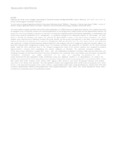Por favor, use este identificador para citar o enlazar este ítem:
http://www.alice.cnptia.embrapa.br/alice/handle/doc/1071445Registro completo de metadatos
| Campo DC | Valor | Lengua/Idioma |
|---|---|---|
| dc.contributor.author | KMIT, M. C. P. | pt_BR |
| dc.contributor.author | LIMA, A. O. S. | pt_BR |
| dc.contributor.author | FREITAS, R. C. | pt_BR |
| dc.contributor.author | ROMAGNOLI, E. M. | pt_BR |
| dc.contributor.author | ABDALLA, A. L. | pt_BR |
| dc.contributor.author | MENDES, R. | pt_BR |
| dc.date.accessioned | 2017-06-23T11:11:11Z | pt_BR |
| dc.date.available | 2017-06-23T11:11:11Z | pt_BR |
| dc.date.created | 2017-06-23 | pt_BR |
| dc.date.issued | 2016 | pt_BR |
| dc.identifier.citation | In: CONGRESO LATINOAMERICANO DE MICROBIOLOGÍA, 23.; CONGRESO ARGENTINO DE MICROBIOLOGIA, 14.; 2016, Rosario. Libro de Resumenes... Rosario: Asociación Latinoamericana de Microbiología; Asociación Argentina de Microbiología, 2016. Ref. JU-1377. | pt_BR |
| dc.identifier.uri | http://www.alice.cnptia.embrapa.br/alice/handle/doc/1071445 | pt_BR |
| dc.description | The rumen harbors complex microbial communities which participate in an efficient process to digest plant biomass. This ecosytem represents an untapped source of hydrolytic enzymes with potential application for second?generation biofuel production from lignocellulosic biomass. The search for new lignocellulolytic enzymes in microbial communities naturally evolved in the biomass degradation, in environments such as the rumen, using the exploration of the metagenome, is a promising strategy for the exploration of genes. In this context, this study aimed to describe the functions and explores the potential for lignocellulolitic enzyme in the sheep rumen microbiome. The rumen samples were collected from 6 fistulated animals (Ovis aries), divided into two groups and subjected to two diets: control and sugarcane bagasse, 60 days after the beginning of the experiment. Metagenomic DNA was extracted from the solid rumen contents and sequencing was performed in MiSeq Personal Sequencer platform (Illumina®). We analyzed, 4,68 GB of metagenomic DNA from microbes adherent to plant fiber using MGRAST metagenomics analysis server. The functional annotation was performed at MG?RAST for the total functional profile using the KEGG orthology level 2. The shotgun metagenomic reads of all animals samples was assigned to putative lignocellulolitic enzymes when considering nine protein databases at MG?RAST. The predictive functional profiling of the sheep rumen microbiome revealed that amino acid and carbohydrate metabolism, translation, DNA replication and repair, and membrane transport are dominant functions in the rumen microbiome. This functional pattern was similar across all animals. As expected, carbohydrate metabolism was highly represented in our data set, supporting the importance of the rumen microbiome for fiber degradation. Reads classification using nine databases resulted in 22 lignocellulases. For instance, the TrEMBL representing 76,77% out of a total 933639 protein abundance, followed by SwissProt representing 39,95 %, Seed 20,71%, PATRIC 5,92%, IMG 3,63%, KEEG 3,44%, GenBank 3,13%, RefSeq 3,09%, eggnog 1,48%. Based on Cazy search for glycosyl hydrolase (GH) families, more than 50 GH families were detected . The most abundant enzymes were ??glucosidase (GH1; GH30), Endo?1,4???xylanase (GH5; GH10; GH51) , ??N?arabinofuranosidase (GH7; GH51; GH54), ??galactosidase( GH27; GH31; GH36), Acetylesterase, Cellulase (GH5; GH9, GH7), Cellobiose phosphorylase (GH94), ??mannosidase(GH2; GH5), ??galactosidase(GH1; GH2; GH35). This results showing the sheep rumen microbiome as a promising source of new fibrolytic enzymes. | pt_BR |
| dc.language.iso | eng | eng |
| dc.rights | openAccess | eng |
| dc.title | Exploring the sheep rumen shotgun sequencing for functional analysis and lignocellulolitic enzyme discovery. | pt_BR |
| dc.type | Resumo em anais e proceedings | pt_BR |
| dc.date.updated | 2017-06-29T11:11:11Z | pt_BR |
| dc.subject.thesagro | Enzima | pt_BR |
| dc.subject.thesagro | Rúmen | pt_BR |
| riaa.ainfo.id | 1071445 | pt_BR |
| riaa.ainfo.lastupdate | 2017-06-29 | pt_BR |
| dc.contributor.institution | M. C. P. KMIT, ESALQ/USP; A. O. S. LIMA, University of Vale do Itajaí; R. C. FREITAS, University of Vale do Itajaí; E. M. ROMAGNOLI, ESALQ/USP; A. L. ABDALLA, CENA, ESALQ/USP; RODRIGO MENDES, CNPMA. | pt_BR |
| Aparece en las colecciones: | Resumo em anais de congresso (CNPMA)  | |
Ficheros en este ítem:
| Fichero | Descripción | Tamaño | Formato | |
|---|---|---|---|---|
| 2016RA086.pdf | 225,57 kB | Adobe PDF |  Visualizar/Abrir |









